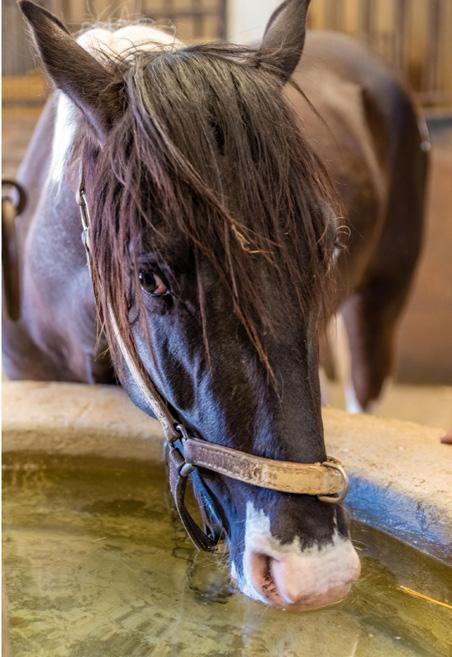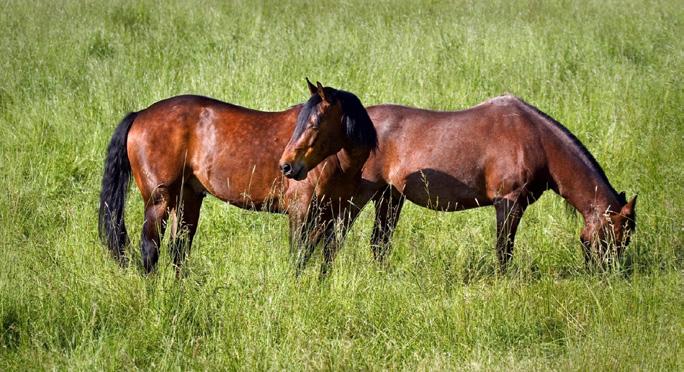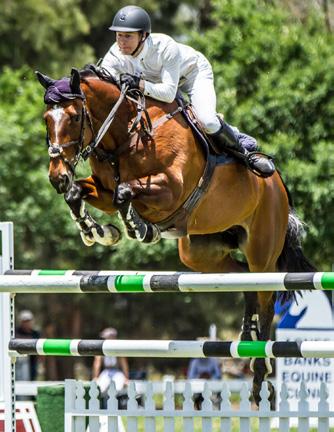
11 minute read
Feature: Back to fitness
Always make fresh, clean water available, especially to a horse that has been sweating.
additional vitamins and an omega-3 fatty acid supplement to replace those levels lost from fresh pasture. Appropriate omega-3 supplements include DHA/EPA algal meal, fish oil, freshly ground or whole linseeds, stabilized linseed oil or chia seeds.
Mycotoxins
Mycotoxins are the naturally occurring toxins produced by certain moulds. Their ingestion is a common cause of horse health and behaviour problems during wet weather and when endophyte (fungi and bacteria) containing varieties of fescue and ryegrass are present. Paspalum is also a high-risk species for mycotoxins during flowering. Many horse pastures will contain levels of myctoxins which are not detectable by the human senses, but are high enough to impact on horse health.
Use of a good quality, broad-spectrum toxin binder containing multiple binding agents is recommended during high humidity or whenever horses show signs of being mycotoxin affected, such as loss of appetite, poor performance, colic and immune-suppression.
Coping with hot summers
Minimising the risk of dehydration and heat stress is a major concern during periods of hot weather. Keeping and riding horses through an Australian summer requires an understanding of how to minimise heat stress and manage electrolyte balance. Working horses during very hot and/or humid weather can be potentially dangerous (even fatal) for both horse and rider. Horses rely heavily on their ability to sweat to cool their bodies during exercise. Sweating is only effective when humidity is low and a breeze is present. Hot, humid and still conditions make it much harder for the body’s core temperature to cool back down to a safe level.
Strenuous exercise and hot environmental conditions are two major factors causing oxidative stress. Oxidative stress occurs when free radicals (reactive oxygen species) outnumber the antioxidant levels in the body, causing cellular and muscle damage, fatigue and decreased performance.
Supplementing with additional antioxidants such as organic selenium, organic chromium, vitamins C and E, carotenoids and enzymes such as superoxide dismutase (SOD) during very hot weather or heavy exercise is scientifically proven to reduce the risk of oxidative stress.
Daily salt requirements
Horses require between seven and 12 grams of plain salt per 100 kilograms of bodyweight every day. This is the amount required for maintenance. Even more is needed for sweat replacement on very hot days and following heavy exercise.
Since salt is usually added to pellets and grain mixes designed for horses, these amounts must be counted in calculations of how much extra salt to add. Top up with plain salt (sodium chloride) which can be purchased as table salt, pool salt,
Find out what species of grasses grow in your region and ensure you supplement with the minerals needed to balance the diet.

flossy salt or stock salt. Free access to a container of clean, loose salt rather than a salt block is also advisable because many horses will not lick a block for long enough to meet their salt requirements.
Sweat replacement
Sweating horses can lose as much as 10 to 15 litres of fluid per hour. Dehydration occurs if this liquid is not replaced. However, it is not as simple as just adding water.
The fluid in animal’s bodies contains various salts called electrolytes (sodium, chloride, potassium, calcium) which help manage the hydration of individual cells and blood volume. The water and electrolytes lost in sweat will be gradually replaced over the course of a few days' rest as the horse drinks water and eats a diet with the correct mineral balance.
However, a faster recovery is often desirable for horses who work every day, or are living in hot and humid environments, or are competing over a number of days. These horses will benefit from a well formulated commercial electrolyte supplement. It is important to feed just the right amount of electrolytes because giving too much or too little can actually increase dehydration.
Always make fresh clean water available to a horse after sweating. Do not offer electrolyte-enhanced water without providing access to plain water.
Mineral supplements
Many horse owners recognise that horses grazing poor quality pasture, or who are on poor soils, need supplementation. But what is not well understood is that even the best quality pasture it’s possible to grow does not give a horse the ideal balance of minerals. Mineral supplements are needed no matter where you are in the world!
What’s the difference between C3 and C4 plants?
It’s all about the way they photosynthesize – that’s the way they use energy from sunlight to convert carbon dioxide and water into energy for plant growth. The vast majority of plants use C3 photosynthesis. y C3 plants store their energy as sugar (fructan) y C3 plants perform best in cooler, moist conditions with moderate sunlight and tend to be temperate plants (ryegrass, clover, wheat, barley, oats) y C4 plants store starch rather than sugar y C4 plants are higher in fibre y C4 plants are more energy efficient and grow much faster y C4 plants have a higher water use efficiency y C4 plants evolved in the warm, strong sunlight areas of the tropics (sugarcane, corn, sorghum, Rhodes grass)
MAIN: In stunning form - Aaron and Easton at the 2018 Sydney Royal (Image by Jenny Shepherd).
FACING PAGE: Braving the cold at the FEI World Cup finals in Sweden (Image courtesy Aaron Hadlow).

FEATURE
Back to fitness
After a layoff, whether through injury or spelling, your horse needs to be brought back to fitness with care. Champion show jumper AARON HADLOW shares the technique he uses to bring his horses into peak competition condition.
Just like us, horses lose muscular and cardiovascular fitness when, for whatever reason, they’re out of training. And also just like us, regaining that edge takes time. The longer your horse has been spelled, the longer it will take to get them back into shape – and that’s a process that can’t be rushed.
Last year, Aaron Hadlow, from Dapto in New South Wales, outdid more than 50 other competitors, many of them full-time professional riders, to win the 2019 Australian League FEI World Jumping Cup with his 11-year-old mare Vahlinvader. In fact, Aaron’s margin leading up to the final competition of the season was so great that his win
was a foregone conclusion even before the first competitor rode into the ring. He also qualified to compete at the 2019 Longines Jumping FEI World Cup held in Gothenburg, Sweden, and Vahlinvader was recognised as the highest ranked horse in the Australian League, winning the Golden Grand Leading Horse Award and outdoing more experienced horses in the process.
The pair’s partnership began when Aaron bought Vahlinvader as a rising four-year-old – and to his very great credit, he’s guided the mare throughout her career, eventually reaching the very top of the sport. that Aaron has plenty of time to ride and to keep his mounts in peak condition, consider this: he holds down a nine-to-five job and has only limited time to spend with his horses. Additionally, at the time of writing, he has seven horses in work, his own and his client’s. Not surprisingly, his day usually starts at 4:00am and finishes, well … late, very late. But despite the time restrictions, Aaron is clearly doing something right when it comes to conditioning and fitness.

Dealing with injuries
Although he says he’s been lucky enough not to have to deal with anything major, Aaron approaches the management of injuries in a thoughtful, structured manner. “After competing at the Caboolture World Cup in July 2018, Vahlinvader was sore from a jar injury. We had to try and keep her in work because the Melbourne Royal was coming up in September. Obviously we couldn’t do anything with her that was load intense, so we swam her a lot so that her legs weren’t under too much stress.”
But as Aaron explains, there were pros and cons to this approach. “What happened was that her back end became muscled up from all the swimming, and because she couldn’t do any other work for about a six weeks, she also started developing the muscle underneath her neck so it was actually making her a bit ‘U’ necked, and generally when we train them we want them to become muscled through the shoulder, up over the wither, and through the neck.”
Although this overdeveloped muscle gave Vahlinvader a slightly upside down look, Aaron knew patience was critical. It was the end game that counted. “When I could start working her properly again it was long and low to stretch her out so she began to

develop the muscles along the top of her neck. It was a slow process and it took a little while to get her back from that, but it was worth the wait.”
When the holiday is over
To get a horse back to fitness, they need regular workouts but the key is not to overdo it. Too much too soon, and you might find yourself coping with needless injuries. For Aaron, recognising that each horse is different is crucial to successfully bringing them back from spelling. “What I do with each horse generally depends on their condition and how fresh they are when you get on them. For example, Vahlinvader tends to get quite heavy when she’s spelling, so I generally lunge her long and low for a week, just gradually building up the pressure so that I’m not jamming her with work. By taking it slowly, I try to avoid any muscle aches, any tying up, and avoid putting her body under too much stress. Then I gradually begin riding her again.” off work Aaron generally starts them back with easy 20-25 minute sessions. “I try not to give them much work after that. Even if your horse is being naughty after spelling, don’t overwork them. I think that can lead to injuries. So instead of only riding three or four days a week, I spread the workload out and do 20-25 minutes six days a week, and over an extended period of maybe two or three weeks so that they slowly build up their muscles and fitness without having maximum load or maximum stress put on their joints.”
Aaron believes that the reason his horses remain virtually injury free has much to do with this slow but steady process. “I don’t bring them in and overwork them just because they might be naughty or pulling. And I
I swim a lot when I’m competing because I find it’s good for my breathing, so I think that it’s the same with the horses.
don’t try to over correct problems too early because I think they’re like us when we’re trying to get fit - we don’t want to go too hard too soon and then three days later not be able to walk. So I have that same philosophy with the horses. If it were me trying to get fit, I wouldn’t want to be putting my body and joints under too much stress by trying to get back up to fitness too soon – and they’re no different.”
Courses for horses
Also trained and ridden by Aaron and enjoying an enviable career is Twins Easton VDL, a horse owned by Twins Performance Horses, who according to Aaron is a little bit naughtier than his other horses. To make allowances for this, Aaron tailors Easton’s program accordingly. “Particularly if I’m going to be busy bringing a lot of horses back into work, I’ll go a little slower with him. General I’ll start him earlier just because he takes that bit longer to get settled and relaxed after having time off. So I start by lunging him for a week, then give him a day off and then I’ll lunge him again. For example, I’ll lunge him from Saturday through to Thursday, give him Friday off, lunge him again on Saturday and then get back on him and slowly follow the same process as with the others. Easton is more forward thinking, and has a little bit more energy, probably the most out of all of them, so giving him that extra time works well for him.”
Slowly does it
After two to three weeks of working his horses long and low on the flat, it’s time to start upping the game. “My plan is to gradually build them up to trotting up the hill on the property where I agist. I start with once a week, then by the time they’re in competition mode, I do a lot of galloping up the hill just to open up their airways. I think that helps a lot.”
Aaron believes his horses’ fitness requirements are similar to his own. “For my fitness I swim a lot when I’m ABOVE: Easton reassures Aaron that there are no hard feelings after that last hill gallop (Image courtesy Aaron Hadlow). LEFT: Aaron and Vahlinvader in flight at the 2017 Sale World Cup (Image by Bronwyn Evans Photography). FACING PAGE: Vahlinvader enjoys some chill time with icing and Equisage therapy (Image courtesy Aaron Hadlow).












